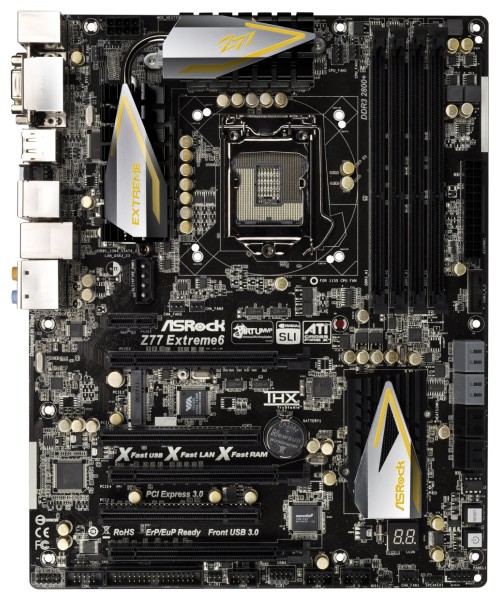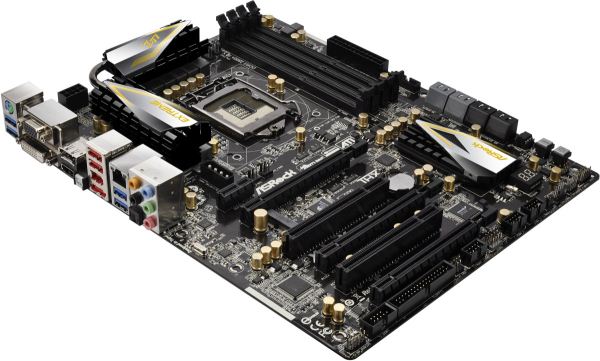Intel Z77 Panther Point Chipset and Motherboard Preview – ASRock, ASUS, Gigabyte, MSI, ECS and Biostar
by Ian Cutress on April 8, 2012 12:00 AM EST- Posted in
- Motherboards
- Intel
- Biostar
- MSI
- Gigabyte
- ASRock
- Asus
- Ivy Bridge
- ECS
- Z77
ASRock Z77 Extreme6—Visual Inspection
With the Extreme6, compared to the Extreme4, there are a significant number of changes, both visual and in terms of features. For a start, the heatsink design is more pronounced, using something similar to their X79 range in terms of black and gold ridged and edged surfaces. The VRM heatsink design is more substantial than the Extreme4, even though online it states it is still only an 8 + 4 VRM design—actually looking at the board, it seems more of a 10 + 4 design.
By looking at the motherboard, you would assume that it would support three-GPU setups. Unfortunately, this third full-length PCIe lane is only PCIe 2.0 x4, rather than splitting up the PCIe 3.0 lanes x8/x4/x4 or using a PLX chip. The MSRP for this board should be around $177, indicating that perhaps that is too cheap a board for one of the expensive PCIe 3.0 expansion PLX chips.

Onboard is also an mSATA port, right in the middle between the first PCIe slot and the PCI slot. Above the PCIe slots is a 4-pin molex power connector to provide extra power to the PCIe slots, although I am kind of getting tired of seeing it put in this location. If anything, it should be at the bottom end or beside the 24-pin power connector, as having it above the PCIe slots just means that there will be cables all over the place.
One other less obvious change to the Extreme4 is that there is a Floppy drive header on board. Yes, you heard me right—floppy drive! It seems odd now to include this legacy connection. It still has a place in industrial concepts (where a machine uses floppy drives and costs 1000x more than the PC processing its data), but not particularly on a higher end product which may be geared towards gaming and overclocking. Perhaps if ASRock are the only ones, then it creates a niche just for them.
In terms of fan headers on board, we have one three-pin beside the 8-pin 12V power connector, two CPU headers (one 4-pin, one 3-pin) just to the right of the top heatsink, two chassis three-pin headers beside the molex connector, and another 4-pin chassis header on the bottom of the board. On the right hand side, the USB 3.0 connector has been placed beneath the 24-pin ATX power connector, followed by the SATA ports. Like the Extreme4, we have the PCH SATA ports (two SATA 6 Gbps and four SATA 3 Gbps) and two extra SATA 6 Gbps from an ASMedia ASM1061 controller.
Around the larger chipset heatsink, we have power/reset buttons and a two digit debug display, both of which I personally like to see as a reviewer (makes my job a bit easier) but also helps overclockers. On the south side of the board, apart from that floppy connector I mentioned, we have a COM port, front panel audio, and an array of USB 2.0 headers.
PCIe layout is similar to the Extreme6, with a PCIe x1, PCIe 3.0 x16/x8, an mSATA connector, PCI, PCIe 3.0 x8, PCI, and a PCI 2.0 x4. This allows a user to use a dual GPU setup, and still have access to a PCIe x1 and x4.

Aside from the bowed picture from ASRock, we have something similar to the Extreme4 for the IO back panel, though this time with a DisplayPort output. From left to right, we have a combination PS/2 port, two USB 3.0 ports (blue), a D-Sub port, DVI-D, DisplayPort, HDMI, a ClearCMOS button, two USB 2.0 (red), an IEEE1394 port, eSATA, gigabit Ethernet, two more USB 3.0 (blue), and audio outputs including an optical SPDIF.
Board Features
| ASRock Z77 Extreme6 | |
| Size | ATX |
| CPU Interface | LGA-1155 |
| Chipset | Intel Z77 |
| Power Delivery | 8 + 4 |
| Memory Slots |
Four DDR3 DIMM slots supporting up to 32 GB Up to Dual Channel, 1066-2800 MHz |
| Video Outputs | DisplayPort, HDMI 1.4a, DVI-D, D-Sub |
| Onboard LAN | Broadcom BCM57781 |
| Onboard Audio | Realtek ALC898 |
| Expansion Slots |
2 x PCIe x16 Gen3 (x16, x8/8) 1 x PCIe x16 Gen2 (x4) 1 x PCIe x1 Gen2 2 x PCI 1 x mini PCIe |
| Onboard SATA/RAID |
2 x SATA 6 Gbps (PCH), Support for RAID 0, 1, 5, 10 2 x SATA 6 Gbps (ASMedia ASM1061) 4 x SATA 3 Gbps (PCH), Support for RAID 0, 1, 5, 10 |
| USB |
Two USB 3.0 at rear (PCH) Two USB 3.0 at rear (Etron EJ168A) One USB 3.0 header (PCH) |
| Onboard |
4 x SATA 6 Gbps 4 x SATA 3 Gbps 1 x Floppy Connector 1 x IR Header 1 x CIR Header 1 x COM Header 1 x SPDIF Header 1 x 4-pin Molex power connector Power/Reset Buttons Two Digit Debug LED 6 x Fan Headers Front panel audio connector 3 x USB 2.0 headers (support 6 USB 2.0 ports) 1 x USB 3.0 header (supports 2 USB 3.0 ports) |
| Power Connectors |
1 x 24-pin ATX connector 1 x 8-pin 12V connector 1 x 4-pin Molex for PCIe |
| Fan Headers |
2 x CPU Fan Header (one 4-pin, one 3-pin) 3 x CHA Fan Headers (one 4-pin, two 3-pin) 1 x SYS Fan Header (one 3-pin) |
| IO Panel |
1 x Combo PS/2 Port 1 x DisplayPort 1 x HDMI 1.4a 1 x DVI-D 1 x D-Sub 1 x Optical SPDIF 2 x USB 2.0 4 x USB 3.0 1 x IEEE1394 1 x Gigabit Ethernet 1 x Clear CMOS Audio Outputs |
| Warranty Period | 3 years from date of purchase |
| Product Page | Link |
Nothing immediately jumps out from the board features list aside from the differences to the Extreme4. This is a quite good package for an MSRP of $171.











145 Comments
View All Comments
extide - Tuesday, April 10, 2012 - link
Do you even know what it means to preempt a frame? Cavalcade is describing the technology correctly. He is explaining pretty much the same thing as you are but you just don't get it..Also separate input and rendering modules means a lot. Typically a game engine will have a big loop that will check input, draw the frame, and restart (amongst other things of course) but to split that into two independent loops is what he is talking about.
Iketh - Wednesday, April 11, 2012 - link
You really should look up "preemption." This is not what is happening... CLOSE, but not quite. Preemption is not the right word at all. This makes him incorrect and I kindly tried explaining. You are incorrect in backing him up and then accusing me of being inept. Guess what that makes you?On top of that, he's also not talking about splitting input and rendering into two loops. Not even close. How did you come up with this idea? He's asking how the input polling is affected with this technology. It is not, and can not, unless polling is strictly tied to framerate.
I want to be clear that I'm not for this technology. I think it won't offer any tangible benefits, especially if you're already over 100 fps, and they want to power up a second GPU in the process... I'm just trying to help explain how it's supposed to work.
Iketh - Sunday, April 8, 2012 - link
"handling input in a game engine" means nothing here. What matters is when your input is reflected in a rendered image and displayed on your monitor. That involves the entire package. Lucid basically prevents GPUs from rendering an image that won't get displayed in its entirety, allowing the GPU to begin work on the next image, effectively narrowing the gap from your input to the screen.Iketh - Sunday, April 8, 2012 - link
mistake post, sorryRyan Smith - Sunday, April 8, 2012 - link
The bug comment is in regards to HyperFormance. Virtual V-Sync is rather simple (it's just more buffers) and should not introduce rendering errors.Ryan Smith - Sunday, April 8, 2012 - link
Virtual V-Sync is totally a glorified triple buffering, however this is a good thing.http://images.anandtech.com/reviews/video/triplebu...
Triple buffering as we know it - with 2 back buffers and the ability to disregard a buffer if it's too old - doesn't exist in most DirectX games and can't be forced by the video card. Triple buffering as implemented for most DirectX games is a 3 buffer queue, which means every frame drawn is shown, and the 3rd buffer adds another frame of input lag.
On paper (note: I have yet to test this), Virtual V-Sync should behave exactly like triple buffering. The iGPU back buffer allows Lucid to accept a newer frame regardless of whether the existing frame has been used or not, as opposed to operating as a queue. This has the same outcome as triple buffering, primarily that the GPU never goes idle due to full buffers and there isn't an additional frame of input lag.
The overhead of course remains to be seen. Lucid seems confident, but this is what benchmarking is for. But should it work, I'd be more than happy to see the return of traditional triple buffering.
HyperFormance is another matter of course. Frame rendering time prediction is very hard. The potential for reduced input lag is clear, but this is something that we need to test.
DanNeely - Monday, April 9, 2012 - link
Lucid was very confident in their Hydra solution; but it never performed even close to SLI/xFire; and after much initial hype being echoed by the tech press it just disappeared. I'll believe they have something working well when I see it; but not before.JNo - Monday, April 9, 2012 - link
Thisvailr - Sunday, April 8, 2012 - link
Page 8 quote: "The VRM power delivery weighs in at 6 + 4 phase, which is by no means substantial (remember the ASRock Z77 Extreme4 was 8 + 4 and less expensive)."Yet: the "Conclusions" chart (page 14) shows the same board having 10 + 4 power.
Which is correct?
flensr - Sunday, April 8, 2012 - link
I'm bummed that ASUS didn't include mSATA connectors. Small mSATA SSDs would make for great cache or boot drives with no installation hassles and they're pretty cheap and available at the low capacities you'd want for a cache drive. That's a feature I will be looking for with my next mobo purchase.Ditching USB 2.0 is also one of the next steps I'll be looking for. Not having to spend a second thinking about which port to plug something in to will be nice once USB 2.0 is finally laid to rest. Having only 4 USB 3.0 ports is stupidly low this long after the release of the standard, and it's hampering the development of USB 3.0 devices.
Finally, I've been repeatedly impressed by my Intel NICs over the last decade. They simply perform faster and more reliably than the other chips. I look for an Intel NIC when I shop for mobos.